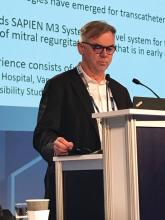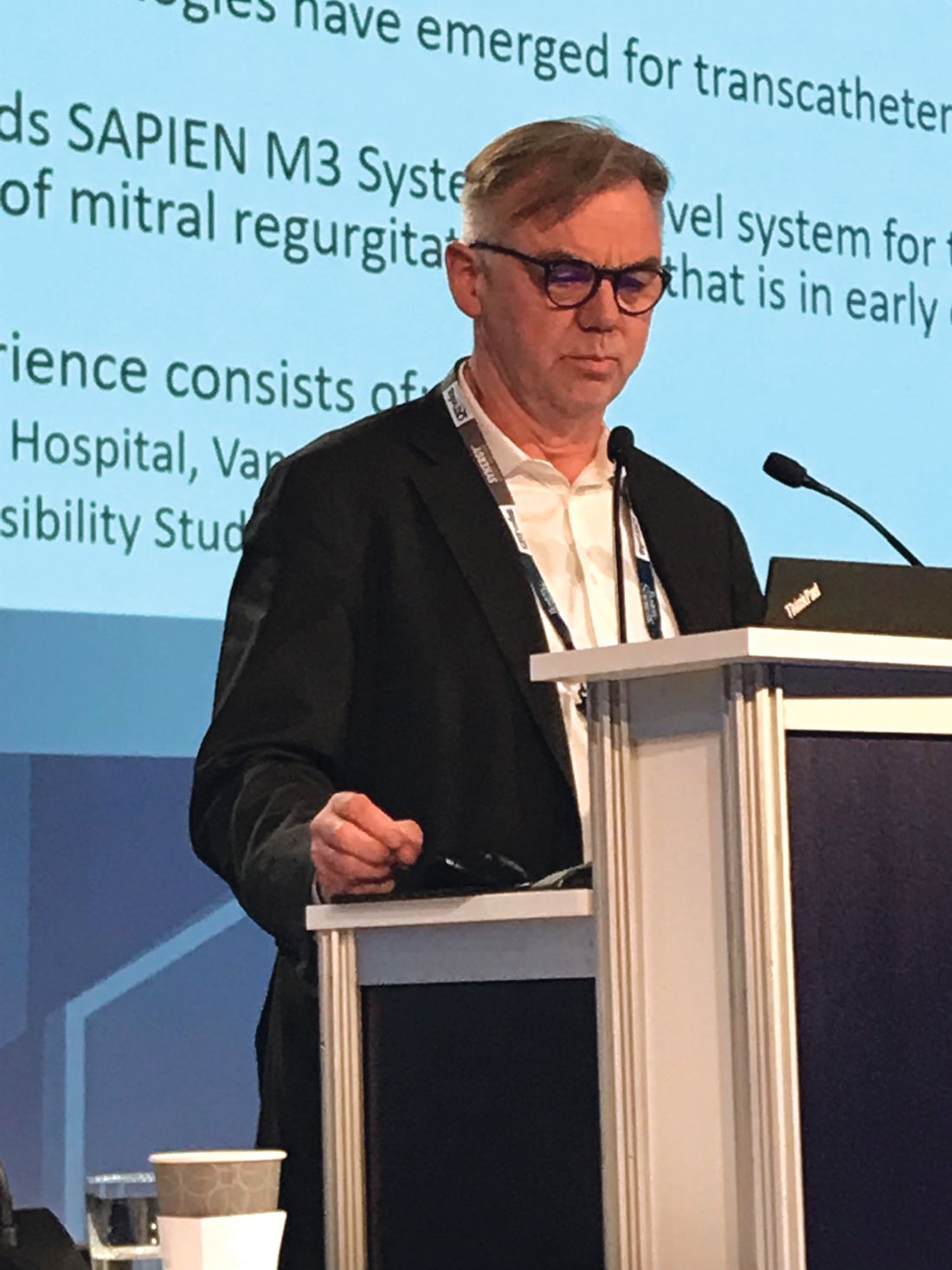User login
WASHINGTON – A novel transcatheter mitral valve replacement with a transseptally introduced docking mechanism that secures the valve with native mitral valve leaflets was found feasible and effective in an initial series of 10 patients, according to a first-in-man report at CRT 2018 sponsored by the Cardiovascular Research Institute at Washington Hospital Center.
“All patients remained hemodynamically stable throughout the procedure, and the valve was successfully implanted in all patients,” reported John G. Webb, MD, McLeod Professor of Heart Valve Intervention at the University of British Columbia, Vancouver.
The docking system “is retrievable up until the point of the final release,” Dr. Webb explained. A knitted polyethylene terephthalate skirt is employed to aid in creating a seal between the leaflets and the dock. Once the docking system is in place, the procedure “then becomes a relatively standard transcatheter transseptal valve-in-valve–type procedure” that is a “fairly easy part of the procedure at centers with transcatheter valve implantation experience.”
The very first case was performed in a 75-year-old woman with severe mitral valve insufficiency. Frail with multiple comorbidities and a left ventricular ejection fraction of 30%, the patient was not a candidate for surgery. Although Dr. Webb acknowledged that the first case “was a learning process,” he reported that the patient was discharged after a 1-night hospital stay with reassuring valve placement and function based on imaging studies.
Data was available from 10 patients from five participating centers in Canada and the United States. The mean age was 74 years, and all were New York Heart Association class III or higher. The mean left ventricular ejection fraction was 37.5%. Although the average Society of Thoracic Surgery risk score was only 4.9%, Dr. Webb noted that this underestimated the vulnerability of a population in which most had compromised renal function. Half of the 10 had severe mitral valve regurgitation prior to valve replacement, and the remainder had moderate to severe regurgitation.
“At the end of 30 days, all had mild or less insufficiency,” Dr. Webb reported. Although one patient did develop significant mitral insufficiency after discharge because of a small tear attributed to probing, it was repaired with a plug. The one technical failure occurred in a patient who required a plug during the course of valve replacement; again, the plug proved effective for preventing significant valve insufficiency.
In this series of patients, one stroke occurred 2 days after the procedure, but there were no deaths in the initial 30-day follow-up, according to Dr. Webb. Although he noted that the procedure time in the first case was 4 hours, the procedure times became shorter with experience and the second-to-last and last cases took 2.5 and 1.3 hours, respectively.
Howard C. Herrmann, MD, director of the interventional cardiology program at the University of Pennsylvania, Philadelphia, and a panelist on the symposium where these data were presented, called the results “exciting.” However, he also noted that “this is the first time that any us have had a look at this device,” so more data will be needed to understand its clinical potential.
Edwards Lifesciences sponsored this study. Dr. Webb reported financial relationships with Abbott Vascular, Edwards Lifesciences, Essential Medical, and Vivitro.
WASHINGTON – A novel transcatheter mitral valve replacement with a transseptally introduced docking mechanism that secures the valve with native mitral valve leaflets was found feasible and effective in an initial series of 10 patients, according to a first-in-man report at CRT 2018 sponsored by the Cardiovascular Research Institute at Washington Hospital Center.
“All patients remained hemodynamically stable throughout the procedure, and the valve was successfully implanted in all patients,” reported John G. Webb, MD, McLeod Professor of Heart Valve Intervention at the University of British Columbia, Vancouver.
The docking system “is retrievable up until the point of the final release,” Dr. Webb explained. A knitted polyethylene terephthalate skirt is employed to aid in creating a seal between the leaflets and the dock. Once the docking system is in place, the procedure “then becomes a relatively standard transcatheter transseptal valve-in-valve–type procedure” that is a “fairly easy part of the procedure at centers with transcatheter valve implantation experience.”
The very first case was performed in a 75-year-old woman with severe mitral valve insufficiency. Frail with multiple comorbidities and a left ventricular ejection fraction of 30%, the patient was not a candidate for surgery. Although Dr. Webb acknowledged that the first case “was a learning process,” he reported that the patient was discharged after a 1-night hospital stay with reassuring valve placement and function based on imaging studies.
Data was available from 10 patients from five participating centers in Canada and the United States. The mean age was 74 years, and all were New York Heart Association class III or higher. The mean left ventricular ejection fraction was 37.5%. Although the average Society of Thoracic Surgery risk score was only 4.9%, Dr. Webb noted that this underestimated the vulnerability of a population in which most had compromised renal function. Half of the 10 had severe mitral valve regurgitation prior to valve replacement, and the remainder had moderate to severe regurgitation.
“At the end of 30 days, all had mild or less insufficiency,” Dr. Webb reported. Although one patient did develop significant mitral insufficiency after discharge because of a small tear attributed to probing, it was repaired with a plug. The one technical failure occurred in a patient who required a plug during the course of valve replacement; again, the plug proved effective for preventing significant valve insufficiency.
In this series of patients, one stroke occurred 2 days after the procedure, but there were no deaths in the initial 30-day follow-up, according to Dr. Webb. Although he noted that the procedure time in the first case was 4 hours, the procedure times became shorter with experience and the second-to-last and last cases took 2.5 and 1.3 hours, respectively.
Howard C. Herrmann, MD, director of the interventional cardiology program at the University of Pennsylvania, Philadelphia, and a panelist on the symposium where these data were presented, called the results “exciting.” However, he also noted that “this is the first time that any us have had a look at this device,” so more data will be needed to understand its clinical potential.
Edwards Lifesciences sponsored this study. Dr. Webb reported financial relationships with Abbott Vascular, Edwards Lifesciences, Essential Medical, and Vivitro.
WASHINGTON – A novel transcatheter mitral valve replacement with a transseptally introduced docking mechanism that secures the valve with native mitral valve leaflets was found feasible and effective in an initial series of 10 patients, according to a first-in-man report at CRT 2018 sponsored by the Cardiovascular Research Institute at Washington Hospital Center.
“All patients remained hemodynamically stable throughout the procedure, and the valve was successfully implanted in all patients,” reported John G. Webb, MD, McLeod Professor of Heart Valve Intervention at the University of British Columbia, Vancouver.
The docking system “is retrievable up until the point of the final release,” Dr. Webb explained. A knitted polyethylene terephthalate skirt is employed to aid in creating a seal between the leaflets and the dock. Once the docking system is in place, the procedure “then becomes a relatively standard transcatheter transseptal valve-in-valve–type procedure” that is a “fairly easy part of the procedure at centers with transcatheter valve implantation experience.”
The very first case was performed in a 75-year-old woman with severe mitral valve insufficiency. Frail with multiple comorbidities and a left ventricular ejection fraction of 30%, the patient was not a candidate for surgery. Although Dr. Webb acknowledged that the first case “was a learning process,” he reported that the patient was discharged after a 1-night hospital stay with reassuring valve placement and function based on imaging studies.
Data was available from 10 patients from five participating centers in Canada and the United States. The mean age was 74 years, and all were New York Heart Association class III or higher. The mean left ventricular ejection fraction was 37.5%. Although the average Society of Thoracic Surgery risk score was only 4.9%, Dr. Webb noted that this underestimated the vulnerability of a population in which most had compromised renal function. Half of the 10 had severe mitral valve regurgitation prior to valve replacement, and the remainder had moderate to severe regurgitation.
“At the end of 30 days, all had mild or less insufficiency,” Dr. Webb reported. Although one patient did develop significant mitral insufficiency after discharge because of a small tear attributed to probing, it was repaired with a plug. The one technical failure occurred in a patient who required a plug during the course of valve replacement; again, the plug proved effective for preventing significant valve insufficiency.
In this series of patients, one stroke occurred 2 days after the procedure, but there were no deaths in the initial 30-day follow-up, according to Dr. Webb. Although he noted that the procedure time in the first case was 4 hours, the procedure times became shorter with experience and the second-to-last and last cases took 2.5 and 1.3 hours, respectively.
Howard C. Herrmann, MD, director of the interventional cardiology program at the University of Pennsylvania, Philadelphia, and a panelist on the symposium where these data were presented, called the results “exciting.” However, he also noted that “this is the first time that any us have had a look at this device,” so more data will be needed to understand its clinical potential.
Edwards Lifesciences sponsored this study. Dr. Webb reported financial relationships with Abbott Vascular, Edwards Lifesciences, Essential Medical, and Vivitro.
REPORTING FROM CRT 2018
Key clinical point: Initial experience with a transcatheter transseptal mitral valve replacement is encouraging.
Major finding: In the first 10 patients, technical success was achieved in 9.
Study details: A summary of first clinical experience at multiple centers.
Disclosures: Edwards Lifesciences sponsored this study. Dr. Webb reported financial relationships with Abbott Vascular, Edwards Lifesciences, Essential Medical, and Vivitro.

